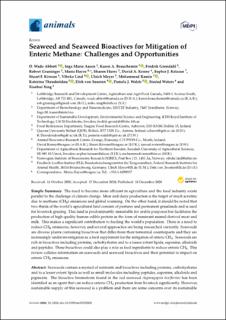| dc.contributor.author | Abbott, D. Wade | |
| dc.contributor.author | Aasen, Inga Marie | |
| dc.contributor.author | Beauchemin, Karen A. | |
| dc.contributor.author | Grondahl, Fredrik | |
| dc.contributor.author | Gruninger, Robert | |
| dc.contributor.author | Hayes, Maria | |
| dc.contributor.author | Huws, Sharon | |
| dc.contributor.author | Kenny, David A. | |
| dc.contributor.author | Krizsan, Sophie J. | |
| dc.contributor.author | Kirwan, Stuart F. | |
| dc.contributor.author | Lind, Vibeke | |
| dc.contributor.author | Meyer, Ulrich | |
| dc.contributor.author | Ramin, Mohammad | |
| dc.contributor.author | Theodoridou, Katerina | |
| dc.contributor.author | van Soosten, Dirk | |
| dc.contributor.author | Walsh, Pamela J. | |
| dc.contributor.author | Waters, Sinead | |
| dc.contributor.author | Xing, Xiaohui | |
| dc.date.accessioned | 2020-12-30T11:24:21Z | |
| dc.date.available | 2020-12-30T11:24:21Z | |
| dc.date.created | 2020-12-18T15:34:58Z | |
| dc.date.issued | 2020-12-18 | |
| dc.identifier.citation | Animals. 2020, 10 (12), . | en_US |
| dc.identifier.issn | 2076-2615 | |
| dc.identifier.uri | https://hdl.handle.net/11250/2721119 | |
| dc.description.abstract | The need to become more efficient in agriculture and the food industry exists parallel to the challenge of climate change. Meat and dairy production is the target of much scrutiny due to methane (CH4) emissions and global warming. On the other hand, it should be noted that two-thirds of the world’s agricultural land consists of pastures and permanent grasslands and is used for livestock grazing. This land is predominantly unsuitable for arable purposes but facilitates the production of high-quality human-edible protein in the form of ruminant animal-derived meat and milk. This makes a significant contribution to feeding the world’s population. There is a need to reduce CH4 emissions, however, and several approaches are being researched currently. Seaweeds are diverse plants containing bioactives that differ from their terrestrial counterparts and they are increasingly under investigation as a feed supplement for the mitigation of enteric CH4. Seaweeds are rich in bioactives including proteins, carbohydrates and to a lesser extent lipids, saponins, alkaloids and peptides. These bioactives could also play a role as feed ingredients to reduce enteric CH4. This review collates information on seaweeds and seaweed bioactives and their potential to impact on enteric CH4 emissions. | en_US |
| dc.language.iso | eng | en_US |
| dc.publisher | MDPI, Basel, Switzerland | en_US |
| dc.relation.uri | https://www.mdpi.com/2076-2615/10/12/2432 | |
| dc.rights | Navngivelse 4.0 Internasjonal | * |
| dc.rights.uri | http://creativecommons.org/licenses/by/4.0/deed.no | * |
| dc.title | Seaweed and Seaweed Bioactives for Mitigation of Enteric Methane: Challenges and Opportunities | en_US |
| dc.type | Peer reviewed | en_US |
| dc.type | Journal article | en_US |
| dc.description.version | publishedVersion | en_US |
| dc.rights.holder | © 2020 by the authors. | en_US |
| dc.source.pagenumber | 28 | en_US |
| dc.source.volume | 10 | en_US |
| dc.source.journal | Animals | en_US |
| dc.source.issue | 12 | en_US |
| dc.identifier.doi | 10.3390/ani10122432 | |
| dc.identifier.cristin | 1861705 | |
| dc.relation.project | EC/H2020/696231 | en_US |
| dc.relation.project | Norges forskningsråd: 308942 | en_US |
| dc.source.articlenumber | 2432 | en_US |
| cristin.ispublished | true | |
| cristin.fulltext | original | |
| cristin.qualitycode | 1 | |

